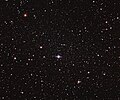Bestand:Carina Dwarf Galaxy.jpg

Grootte van deze voorvertoning: 719 × 600 pixels. Andere resoluties: 288 × 240 pixels | 576 × 480 pixels | 921 × 768 pixels | 1.228 × 1.024 pixels | 2.456 × 2.048 pixels | 3.771 × 3.145 pixels.
Oorspronkelijk bestand (3.771 × 3.145 pixels, bestandsgrootte: 5,64 MB, MIME-type: image/jpeg)
Bestandsgeschiedenis
Klik op een datum/tijd om het bestand te zien zoals het destijds was.
| Datum/tijd | Miniatuur | Afmetingen | Gebruiker | Opmerking | |
|---|---|---|---|---|---|
| huidige versie | 24 feb 2015 15:14 |  | 3.771 × 3.145 (5,64 MB) | FDMS4 | Reverted to version as of 14:03, 28 June 2011. |
| 24 feb 2015 05:00 |  | 3.768 × 3.144 (5,78 MB) | SteinsplitterBot | Bot: Image rotated by 180° | |
| 28 jun 2011 16:03 |  | 3.771 × 3.145 (5,64 MB) | Jmencisom |
Bestandsgebruik
Dit bestand wordt op de volgende 2 pagina's gebruikt:
Globaal bestandsgebruik
De volgende andere wiki's gebruiken dit bestand:
- Gebruikt op af.wikipedia.org
- Gebruikt op ar.wikipedia.org
- Gebruikt op ast.wikipedia.org
- Gebruikt op ca.wikipedia.org
- Gebruikt op de.wikipedia.org
- Gebruikt op el.wikipedia.org
- Gebruikt op en.wikipedia.org
- Gebruikt op es.wikipedia.org
- Gebruikt op fi.wikipedia.org
- Gebruikt op fr.wikipedia.org
- Gebruikt op he.wikipedia.org
- Gebruikt op id.wikipedia.org
- Gebruikt op it.wikipedia.org
- Gebruikt op ja.wikipedia.org
- Gebruikt op ko.wikipedia.org
- Gebruikt op mk.wikipedia.org
- Gebruikt op no.wikipedia.org
- Gebruikt op pl.wikipedia.org
- Gebruikt op pt.wikipedia.org
- Gebruikt op ro.wikipedia.org
- Gebruikt op ru.wikipedia.org
- Gebruikt op si.wikipedia.org
- Gebruikt op sk.wikipedia.org
- Gebruikt op tr.wikipedia.org
- Gebruikt op uk.wikipedia.org
- Gebruikt op vi.wikipedia.org
- Gebruikt op www.wikidata.org